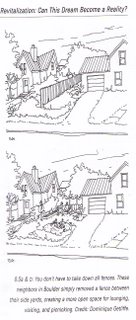
Let me be clear. I agree with James Howard Kunstler. "Suburbia is the greatest misallocation of resources in the history of the world." The idea that we can live and work, play and teach, manufacture and grow everything necessary to foster some sort of meaningful life miles away from each other is silly. It has worked for a short time because we have been able to tap an incredible energy source that took millions of years to materialize. The only energy input onto this planet Earth is radiation from our sun. It has been stored over the ages by plants. Some of these plants died and decomposed in such a way that their remains were converted by heat and geological action into the petroleum we are now using at a rate of over 20 million barrels per day here in the 
The built environment of civilization on any number of density levels has remained roughly the same for thousands of years. Cities in ancient times were not so dissimilar from cities observed during the beginning of the 1800’s. People, on average, are only able to walk so far without becoming tired. The physical arrangements of ancient towns developed out of a response to the needs and capabilities of humans with specific resources at their disposal. Dietary requirements and other staples of life have not become radically altered during the past 50 years but they way we build human habitations has. I don’t blame those who created the post WWII suburbs for bankrupting the American people. I doubt they would have proceeded if they had stopped and seriously considered the ramifications of what they were doing. The truth is most of them still don't get it 50 years later. The cheap price of energy has blinded most Americans who are more than willing to embrace the idea that there is always more of everything available. They are slow to face the fact that the laws of physics are not breakable; even by the ingenious human mind.
But how can you begin to make this sort of change in your neighborhood in advance of the Long Emergency set to arrive with the peaking of global oil production? How can you prepare as a neighborhood to meet more of your needs as the price of fuel steadily increases? What can you do to facilitate change in your community? That is what this book is about. The relationships involved in any situation help determine the outcome. You might want to take steps towards creating a more self sustainable neighborhood but what is the best way to share that goal with your neighbors? Superbia! is a guide to understanding the human dynamics of neighborhood change. I would recommend it to anyone who hopes to affect revision in his or her community.


2 comments:
Hi Aaron.....our Google alert told us of your article on the book review on "Superbia"! We got it because of your reference at the bottom telling who you are and your doing the all-nite blog thing promoting Trees for Life :)
Thanks for your commitment to change and believing it can happen. And thanks for blogging about our organization!
Treva Mathur, Office Coordinator
Trees for Life
I just finished reading Superbia, and I have to admit that I thought that it was a little "thin". I thought that the jump from having a few neighbors over for a pot luck dinner to tearing down fences and creating a public space in the back yards was tenous at best. I like the idea, and am sure that in some areas of the country you'd have progressive thinkers who would welcome changes like the ones proposed in the book, but, more realistically, I would have preferred information on how to start grass roots movements to improve public transportation, adding sidewalks, and bike paths. What public authorities to contact and petition, what sources of funding to make infrastructure changes etc. I liked very much what the authors had in mind, and the skeleton outline that they provided. I think that there should have been a little more time and pages dedicated to the "baby steps" that need to be taken to get changes like this off the ground.
I didn't like how they said that someone in the neighborhood didn't like what the group proposed, so they had to move away. I think that real solutions to these problems and real results will only be achieved through inclusion of everyone in the neighborhood, how can you realistically deal with someone in your neighborhood who is against sidewalks, public transportation and the like? I don't have the time to rant further on this now, but as you can see I think that there is plenty of room for further discussion on this. I recommend this book, but at a "take out from the library" level, not buy a used one...
Post a Comment